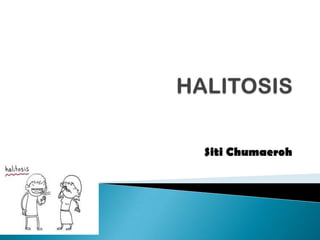
Halitosis
- 2. Halitosis from the Latin halitus for breath = malodour = foetor ex ore - unpleasent odors in breathing - mainly in adult 30% over 60 year - psichogenic basis - to be the third most frequent reason for seeking dental aid - 85-90% orginates in the mouth itself
- 3. - morning breath - a low salivary flow - oral cleansing during sleep - during the day : - foods : garlic, onion or spices - habits (smoking, drinking alcohol) - oral bacterial activity anaerobes
- 4. Oral bacterial activity arising from : * poor oral hygiene * gingivitis (especially necrotizing gingivitis) * periodontitis * pericoronitis * infected extraction sockets * residual blood postoperatively * debris under bridges or appliances * ulcers * dry mouth
- 5. Porphyromonas gingivalis Prevotella intermedia Fusobacterium nucleatum Bacteriodes forsythus Treponema denticola produce the chemicals that cause malodour The tongue is the location of organisms above
- 7. The chemicals include: * volatile sulphur compounds (VSC’s) mainly: - methyl mercaptan - hydrogen sulphide - dimethyl sulphide * polyamines : - putrescine - cadaverine * short-chain fatty acids : - butyric acids - valeric acids - propionic acids
- 8. Odors are due to the breakdown of certain proteinsindividual amino acids Certain aminoacids foul gases Forexamples : breakdown cystein & methionine hidogen sulfide methyl mercaptan Volatile sulfur compounds stastically associated with malodour
- 9. Starvation Drugs : - amphetamines - chloral hydrate - cytotoxic agents - dimethyl sulphoxide (DMSCO) - disulfiram - nitrates and nitrites - phenothiazines - solvent abuse
- 10. * Diabetes diabetic acidosis aceton * Respiratory disease Nasal sepsis Infection of paranasal sinuses Infection of respiratory tract : - tonsilitis - bronchitis - lung infect. - tumors, etc * Gastrointestinal disease : intestinal bleeding * Hepatic failure: chronic rare * Renal failure : uremia in saliva amonia * Psychosomatic factors (halitophobia ) 0,5-1%
- 11. Volatile sulphur compounds Cysteine desulphydrase Methionine desulphydrase M A L O D O U R URu R Debris Blood Aminoacids Cysteine Methionine Oral bacteria P. gingivalis F. nucleatum Prev. intermedia B. forsythus T. denticola SYSTEMIC Lungs Gastrointesti nal Hepatic Renal diabetes Dimethyl disulphide (CH₃)₂SH Methyl mercaptan CH₃SH Hydrogen sulphide H₂S Psychogenic
- 12. HALITOSIS Is there objective halitosis? Recently ingested foods such as garlic, curry, onion, duria n, etc? Drugs : alcohol, chloral, nitrites/nitrates , DMSO, cytotoxics, phenothiazi nes, amphetamines or smoking Foods Psychogenic, psychosis or cerebral tumour Drugs/smoking responsible? Oral sinus or pharyngeal infections? Xerostomia? Respiratory disease, hepatic disease, renal disease, gastrointestinal disease, diabetes mellitus, or other condition See “dry mouth” Abcess, dry socket, pericoronitis, acute ulcerative gingivitis, tonsilitis, sinusitis or nasal or foreign body No Yes Yes Yes Yes No Ye s N o N o N o
- 13. Materia alba and marginal gingivitis
- 14. Plaque accumulation and gingivitis
- 15. Dentures can produce accumulation of microbial plaque ( bacteria and/or yeast) on and in the fitting surfaces of the denture and underlying mucosa The plaque undergoes sequential development is colonized by organisms The decreased salivary flow A low PH under the denture inflammation denture –related stomatitis
- 16. - full history - examination - assessment of halitosis - volatile sulphur compounds halimeter - oral flora
- 18. - Patient education - Treating the cause - Avoiding smoking, foods such as onion, garlic etc - Good oral hygiene : tooth brushing, flossing, tongue cleaning (before going to bed) - Oral antiseptics - Denture care
- 20. Wearing a denture encourage food accumulation , the denture plaque and fitting surface be infected with microorganism usually C. albican - Keep as clean as natural teeth - Clean both surfaces inside and outside after meal and at night using washing up liquid , toothbrush and warm water hold it over a basin containing water
- 21. - should be left out overnight and keep them in water it may distort if allowed to dry out - An infection are increased if the denture are worn 24 hours a day
- 22. If the denture is infested with microorg should be removed Denture left out the mouth at night Clean , disinfected Stored in an antiseptic denture cleanser Denture soak solutions containing benzoic acid eradicate C albicans from denture surface internal surface of prosthesis Chlorhexidine : reduction palatinal infection Mucosal infection by brushing the palate using antifungal for 4 weeks
- 23. TERIMA KASIH
